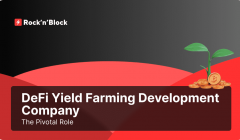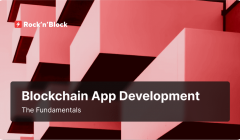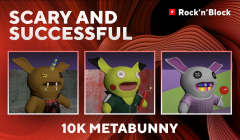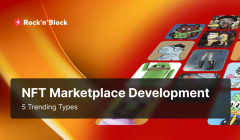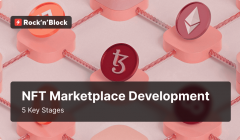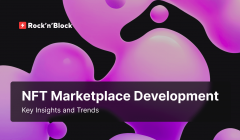NFT Marketplace Development: Everything You Need to Know
03 May 2024Embarking on the journey of NFT marketplace development from scratch is a thrilling venture that opens doors to the future of digital transactions and ownership. In this comprehensive guide, we explore the intricate process of creating an NFT marketplace that aligns with your unique vision. Starting from the conceptual stage to deployment, we will delve into the essential stages, critical factors, and innovative approaches that embody a successful venture into the world of NFT app development.
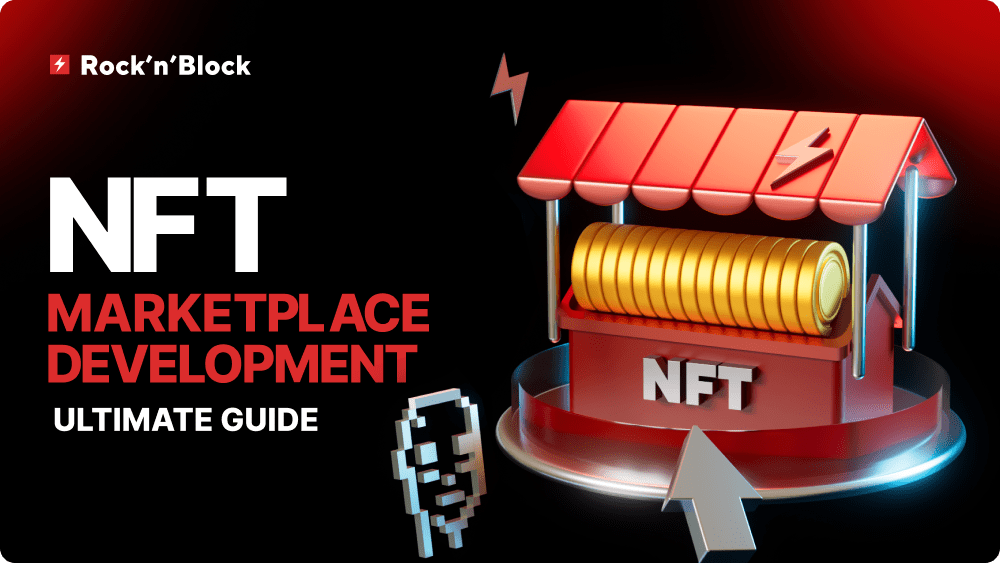
Table of Contents:
-
NFT Marketplaces: a Brief Overview
-
Structural Design of an NFT Marketplace
-
Technologies and Service Integrations
-
The Processes of Creating and Buying an NFT
-
The Process of Uploading an NFT Asset
-
The Process of Buying an NFT
-
Key Features of an NFT Marketplace
-
When Customization Comes in Handy
-
How Much Does it Cost to Build an NFT Marketplace?
-
What You Need to Know Before Developing an NFT Marketplace
-
Successful Examples of NFT Marketplaces
-
Conclusion
NFT Marketplaces: a Brief Overview

NFT marketplaces are dynamic online platforms where creativity and individuality come together to create unique digital treasures. Imagine a vibrant virtual exhibition where artists, gamers, and creators gather to showcase their one-of-a-kind works. These marketplaces exist exclusively on the decentralized platform of the blockchain and are far from conventional brick-and-mortar establishments.
Each digital artifact, from mesmerizing artworks to rare virtual assets, is now enclosed within a non-fungible token, transforming it into an incomparable cryptographic masterpiece. NFT marketplaces development merges rarity with technology, and ownership is securely recorded on the immutable blockchain ledger. Once inside an NFT marketplace, you'll be immersed in a wonderland of creativity, where pixels take on priceless value, and the intangible becomes a coveted commodity.
Structural Design of an NFT Marketplace
The design of an NFT marketplace plays a crucial role in shaping the platform's functionality, user experience, and overall success. This part encompasses the architecture, layout, and organization of key components, ensuring a seamless and intuitive experience for both creators and collectors.
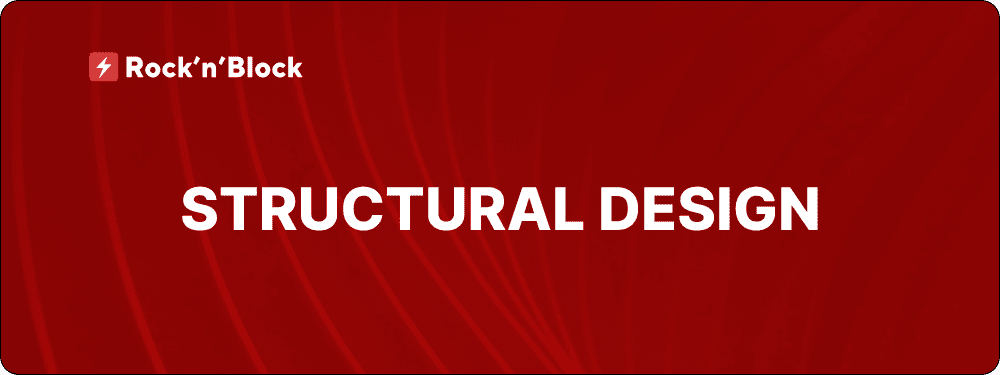
NFT Marketplace App Itself
An NFT marketplace application is a digital platform enabling users to buy, sell, and trade non-fungible tokens. These tokens authenticate ownership of various digital assets, including artwork, collectibles, or tokenized real world assets. The application operates on blockchain technology, guaranteeing secure and transparent transactions. Users can browse a variety of exclusive digital assets, each with its own distinctive value and rarity. It offers a simplified interface for exploring the realm of NFTs, making it easily accessible for creators and collectors to partake in the flourishing digital economy.
Smart Contracts
Smart contracts play a pivotal role in the NFT marketplaces development, serving as the backbone that facilitates and automates various functionalities.
NFT contract factories, a crucial component, enable the creation of multiple NFT contracts based on predefined templates. These templates define the structure and properties of the NFTs, streamlining the minting process for creators. By utilizing contract factories, developers can efficiently deploy standardized NFT contracts, ensuring consistency and interoperability across the marketplace.
Additionally, payment contracts handle secure and transparent transactions. Payment contracts automate the exchange of cryptocurrencies, providing a seamless experience for buyers and creators. The trustless and automated nature of smart contracts not only enhances the efficiency of NFT marketplace development but also ensures the integrity and authenticity of digital assets on the blockchain.
Frontend Development
The frontend in NFT marketplace development is like the 'storefront' of the application - it's what users see and interact with directly. It comprises the layout, design, and features that enable users to effortlessly browse and use the platform. The on-screen elements, such as NFT images, clickable buttons, search bar, and user profiles, constitute the frontend. So, when you're exploring or purchasing NFTs, the user interface is the segment of the application that you're viewing and engaging with.
The frontend in NFT marketplace development encompasses various components, including:
1. User Interface (UI): This involves the design and layout of the app, including how information is presented, the visual aesthetics, and the overall look and feel.
2. User Experience (UX): UX aims to create a favorable and user-friendly interaction for customers. This involves crafting workflows, navigation, and features that allow for seamless and pleasurable exploration, discovery, and interaction with NFTs.
3. Navigation: Menus, buttons, and other navigational elements that guide users through the app.
4. Search and Discovery Features: Filters, sorting options, and search functionalities.
5. User Profiles: Showing information about the user, their NFT collection, transaction history, and any other relevant details.
6. NFT Listings: The display of NFTs available for purchase or auction, which encompasses information such as images, descriptions, and pricing, constitutes a component of the front-end design.
7. Interactive Features: Features such as likes, comments, sharing options, and social engagement functionalities.
8. Wallet Integration: The interface includes features for users to link and engage with their digital wallets, enabling them to oversee their non-fungible tokens, check balances, and commence transactions.
In summary, the frontend in NFT marketplace development is the user-facing side that encapsulates design, interactivity, and user experience elements, providing a visually appealing and intuitive platform for users to engage with NFTs.
Backend Development
In simple terms, the frontend NFT marketplace development is akin to the "behind-the-scenes" operation of the app. Whereas the frontend is what users can see and interact with, the backend carries out the necessary processes to ensure seamless operation. Think of it as a car engine — it may be hidden, but it drives the entire vehicle. The backend deals with managing data, processing transactions, and guaranteeing secure and efficient operation. When purchasing or selling NFTs, the backend system ensures that accurate information is stored, while transactions remain secure and all actions are completed as expected behind the scenes.
Key elements of the backend include:
1. Server: The backend is hosted on servers that manage and process data. These servers handle requests from the frontend, execute business logic, and interact with databases.
2. Database: The backend usually depends on a database to efficiently store and recover data. The database maintains details on NFTs, user accounts, transactions, and other pertinent data.
3. IPFS (Interplanetary File System): In the NFT marketplaces development, IPFS distributes NFT data across a peer-to-peer network, which enhances resilience.
3. Business Logic: It includes functionalities such as handling transactions, managing user accounts, enforcing security measures, and ensuring the integrity of the NFT ecosystem.
4. User Authentication and Authorization: The backend is responsible for authenticating users to ensure secure account access and determining the access level and permissions granted to each user.
5. Integration with Blockchain: The backend interacts with the blockchain to execute smart contracts, verify transactions, and retrieve information about NFT ownership and authenticity.
6. Payment Processing: If the NFT marketplace involves transactions with fiat currency, the backend handles payment processing, ensuring secure and seamless transactions.
7. Notifications: The backend can create and dispatch notifications to users when certain events occur, including successful transactions, new bids, or updates on NFT listings.
8. Scalability and Performance Optimization: The backend is designed to be scalable to accommodate growing user bases and transaction volumes.
9. Security Measures: Security measures such as encryption, secure communication protocols, and protection against common vulnerabilities have been put in place on the backend of the NFT marketplace development to ensure the safety of user data and maintain platform integrity.
10. APIs (Application Programming Interfaces): The backend often implies APIs that allow communication between the frontend and backend components. These APIs facilitate data exchange and enable the frontend to interact with the back-end functionalities.
11. Logging and Monitoring: The NFT marketplace's backend development features logging mechanisms to record system activities and errors for troubleshooting purposes. Additionally, the application's performance and health are tracked by monitoring tools.
In essence, the NFT marketplace development backend comprises the technological infrastructure that sustains and energizes the frontend. It is responsible for handling data, executing business logic, communicating with the blockchain, ensuring security, and delivering necessary features to provide a sturdy and efficient user experience.
Technologies and Service Integrations
In the dynamic landscape of NFT marketplace development, the integration of various technologies and third-party services is pivotal to create a seamless and efficient ecosystem.
Infura.io
Infura.io, a prominent infrastructure provider, offers Ethereum node services, which are essential in enhancing scalability and reducing operational complexities, thus alleviating the need for developers to run their own Ethereum nodes. As a blockchain platform, Ethereum is fundamental to NFTs, serving as the foundation for smart contracts development that power the creation, transfer, and ownership of non-fungible tokens.
The integration of Infura with Ethereum allows access to the Ethereum network, enabling seamless interactions between NFT marketplace applications and the blockchain.
CoinMarketCap
CoinMarketCap offers comprehensive data on cryptocurrency prices, market capitalization, and trading volume. NFT marketplaces often integrate with CoinMarketCap to provide users with up-to-date pricing information, fostering transparency and informed decision-making.
The Processes of Creating and Buying an NFT
Once we grasp the technical architecture of NFT marketplace development, let's examine the procedure from the user's standpoint. This would entail purchasing NFTs in-app or uploading their own assets to the platform.
The process of uploading and purchasing NFTs on an NFT marketplace app combines a simple-to-use interface with powerful backend features, producing a unified and safe space for creators and collectors to explore the dynamic realm of non-fungible tokens.
The Process of Uploading an NFT Asset
After the creator logs into the NFT marketplace app, accesses their account through the frontend interface, the process of uploading an NFT asset on an NFT marketplace app typically involves the stages below.
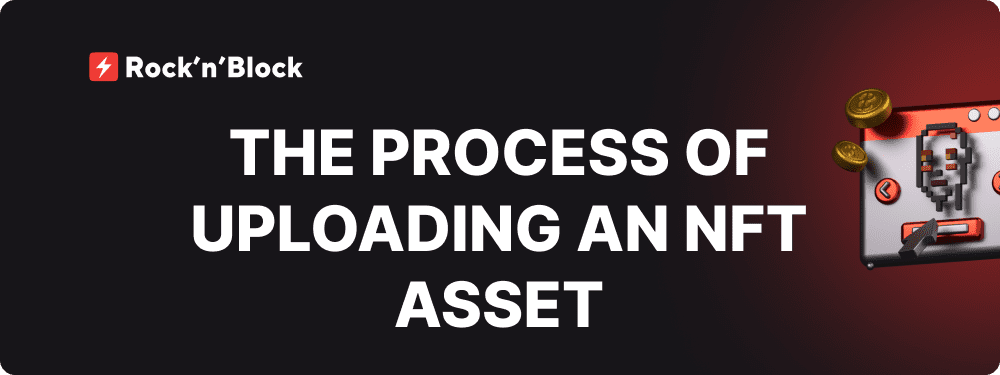
Let’s Start with Digital Wallets
For creators looking to upload their digital assets, the process typically begins with accessing their digital wallet integrated into the app. Through the app's frontend, they connect their wallet to the marketplace for secure NFT management.
Provide Asset Details and Upload Media Files
The NFT creator provides information regarding the NFT, including metadata like title, attributes, description, and other pertinent data. Additionally, the creator uploads the digital media files which make up the NFT's visual and auditory parts, such as images, audio, or videos.
Finally, the creator may establish ownership terms, specifying contractual terms for usage rights, royalties, or other relevant details, depending on the NFT marketplace app.
The digital file representing the NFT asset is then uploaded to IPFS. IPFS uses a content-addressed system, assigning a unique hash to each file based on its content. This hash becomes the immutable link to the asset.
Deploy Smart Contracts
The application's backend system interacts with the blockchain by deploying a smart contract to create the NFT on the selected blockchain. The IPFS hash is written to the NFT's smart contract on the blockchain. This connection ensures that the NFT is associated with the specific digital content hosted on IPFS. This procedure guarantees the originality and genuineness of the NFT.
Confirmation and Visibility
Once the smart contract is deployed, the NFT is displayed on the marketplace for potential buyers to see. The creator is notified that the creation process was successful.
Marketplace Listing
The newly created NFT has been deployed to the blockchain and listed on the marketplace, enabling it to be bought or auctioned. Users can now explore, discover, and interact with the digital asset created by the artist.
Ethereum is the blockchain that is most prominently used for NFT marketplaces as it stores the NFT identifiers and links them to the corresponding digital assets.
Following the carefully devised steps by the NFT marketplace developers, creators can seamlessly upload their NFT assets to the platform. The user-friendly frontend and robust functionalities of the backend infrastructure and blockchain technology are utilized for this purpose.
The Process of Buying an NFT
Same as for creators, users start by opening the NFT marketplace app, interacting with the intuitive frontend interface, and creating an account if they do not already have one.
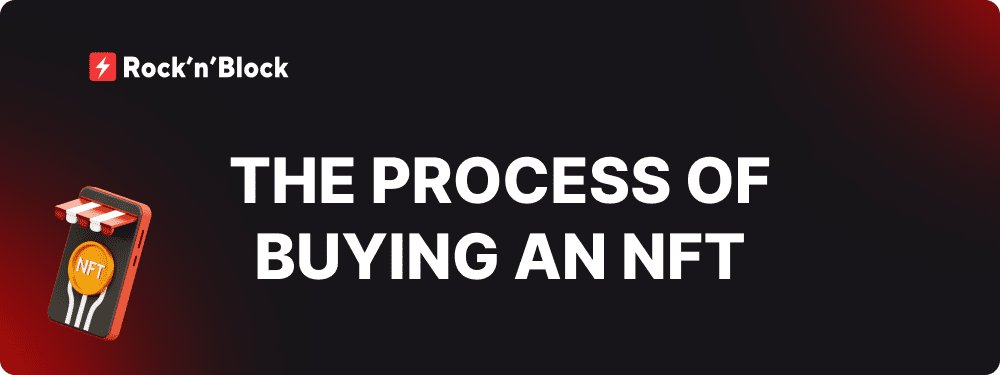
Connect Digital Wallet
Users securely connect their digital wallets within the application. The wallet functions as a storage for funds and NFT holdings and generates public and private keys for secure transactions.
To acquire NFTs, the user must first fund their digital wallet.
Explore the Marketplace and Select Desired NFT
Users browse the app's frontend to discover NFTs using the search and discovery functionalities integrated during the NFT marketplace development. Once the user chooses their desired NFT, they can simply click the purchase button to buy it.
Confirming the Transaction
The user checks and approves the transaction details, such as the price, applicable gas fees, and any other pertinent information and gives the smart contract permission to interact with the user’s funds. The user needs to approve by signing the transaction through their digital wallet, which prompts a transaction request that the app interfaces with the blockchain to initiate the NFT's associated smart contract.
Execute Smart Contract
The app connects with the blockchain to execute a smart contract, ensuring secure ownership transfer and authenticity verification.
Transaction Confirmation
Once the smart contract executes successfully, the user receives a confirmation that the transaction is complete. The NFT then appears in the user's digital wallet as part of their collection. The backend's role is capturing and relaying smart contract events and passing information to the frontend to provide users with adaptive, immediate and accurate feedback on their transactions.
Viewing and Managing NFTs
The user can now view, manage, and trade their NFTs within the app. The ownership details and transaction history are securely stored on the blockchain.
This staged process highlights the tight integration of frontend and backend functionality in the NFT marketplace development, providing users with an intuitive and secure process for purchasing NFT assets.
Key Features of an NFT Marketplace
An effective NFT marketplace development typically boasts a set of key features that cater to the needs of both creators and collectors. These features contribute to the overall functionality, security, and user experience within the marketplace. Some key features are listed below.
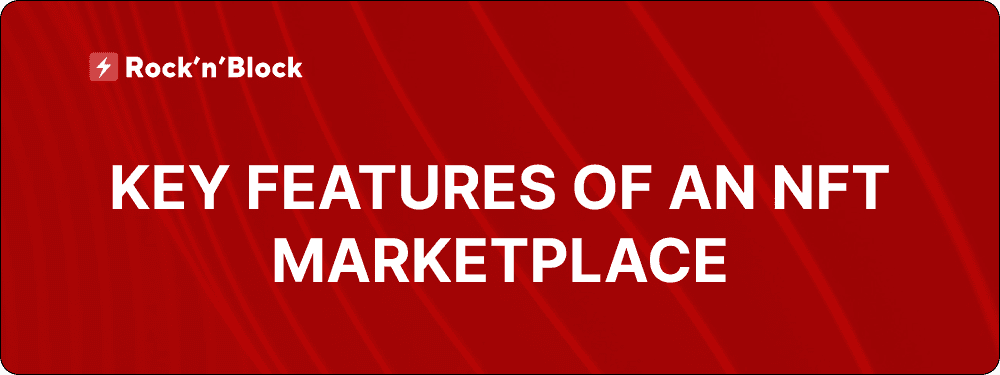
1. Creator Tools and Minting
Tools enabling creators to create their NFTs easily, providing choices to set ownership terms, royalties, and other pertinent details affiliated with the token creation process.
2. Auction and Bidding System
Support for both fixed-price sales and auction-based models, allowing creators to select the most appropriate method for selling their NFTs.
3. Multi-Currency Payments
In the realm of NFT marketplace development, enabling multi-currency payments adds a dynamic and inclusive dimension to the user experience. Supporting multiple currencies empowers users to conduct NFT transactions using a variety of cryptocurrencies or fiat currencies, thus broadening accessibility for a global audience.
4. Secure and Transparent Transactions
Integration with blockchain technology to ensure the security and transparency of transactions, providing users with verifiable ownership and provenance of NFTs.
5. Royalty Management
Automated royalty distribution mechanisms within smart contracts, ensuring that creators receive a percentage of secondary market sales of their NFTs.
6. Comprehensive Metadata Support
The capacity to affix and view extensive metadata to NFTs, including details of the creator, date of creation and any other relevant information that adds value and context to the digital asset.
7. Analytics and Reporting
Tools for users and creators to track the performance of their NFTs, including sales history, transaction data, and overall market trends.
8. Scalability and Performance
A scalable infrastructure to handle growing user bases and high transaction volumes without compromising performance.
9. Extensive Customization Options
The level of customization in the NFT marketplace development enables bespoke design elements and smart contracts which reflect the unique identity and objectives of each client.
When Customization Comes in Handy
Custom NFT marketplace development provides numerous benefits, making it an attractive option for businesses and individuals in search of a bespoke and distinctive platform for their non-fungible tokens.
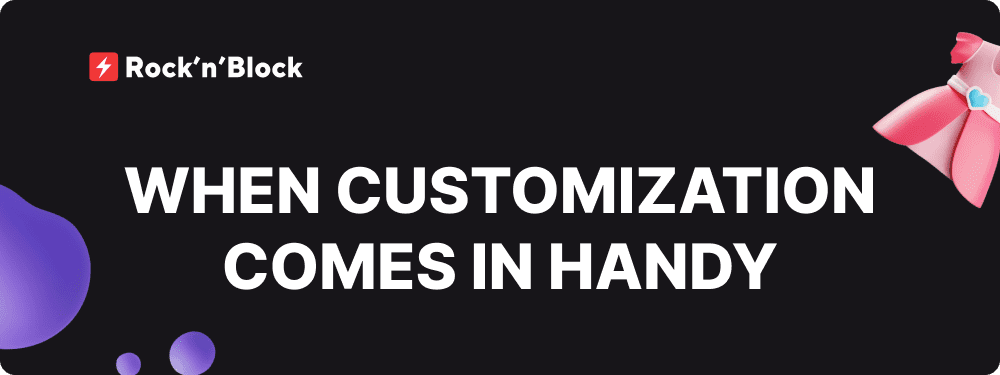
Key Reasons in Favour of Custom NFT Marketplace Development
Custom NFT marketplace development offers a range of advantages, here are some of them:
1. Brand Alignment
A custom NFT marketplace allows businesses to align the platform's design, interface, and overall user experience with their brand identity, reinforcing brand consistency and recognition.
2. Unique Features and Functionalities
Tailoring a product to meet specific business requirements or industry needs through customization provides a competitive edge in the market, by integrating unique features and functionalities.
3. Scalability Boost
Customizing the marketplace facilitates scalability in line with projected growth. Bespoke development guarantees that the platform can effortlessly expand to cater for a rising user base and growing transaction volume.
4. Targeted User Experience
Understanding the target audience is crucial in NFT marketplace development. Customization enables the creation of a user-centric experience, considering the preferences and behaviors of the intended users.
5. Specific Blockchain Integration
Tailoring enables to integate private blockchain networks, refining output, expandability, and transaction pace to match the specific objectives.
6. Security and Compliance Foster
Custom solutions offer greater control over security measures and compliance requirements. Businesses can implement advanced security protocols and ensure adherence to specific regulatory standards relevant to their industry.
7. Ownership and Control
Businesses have complete ownership and control of the bespoke NFT marketplace, minimizing the reliance on third-party solutions and enabling the freedom to execute alterations or updates as necessary.
8. Various Monetization Strategies
Tailoring the platform allows for personalized monetisation strategies to be put into action, such as transaction fees, premium memberships or other revenue streams that align with the business model.
9. Increased Adaptability to Newest Market Trends
Custom NFT marketplace development ensures the flexibility to adapt to evolving market trends and user preferences. This adaptability is crucial for staying competitive and meeting the dynamic demands of the NFT ecosystem.
10. Innovation and Uniqueness
A custom NFT marketplace stands out in the market for its innovation and uniqueness. It provides the opportunity to experiment with novel concepts and design elements, contributing to a distinctive and memorable user experience.
Custom NFT marketplace development has a multitude of benefits for businesses. Companies can create bespoke platforms, tailored to their individual requirements, therefore, offering a unique and impactful presence in the highly competitive NFT landscape.
The level of customization permits design elements and smart contract intricacies to reflect the distinctive identity and goals of each client.
It enables developers to create NFT marketplaces that not only meet but exceed the expectations of their clients.
How Much Does it Cost to Build an NFT Marketplace?
NFT marketplace development cost can vary widely depending on several factors, including the complexity of the platform, desired features, blockchain selection, technology stack and the development approach. Let's break down the key components that contribute to the costs of building an NFT marketplace.
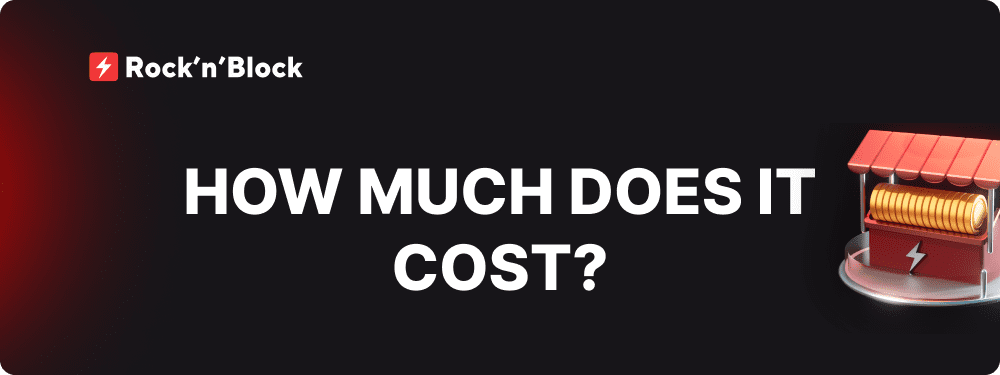
1. Development Team: The selection of an NFT marketplace development company has a significant impact on costs. Rates differ based on the team's geographical location, level of expertise, and experience in development.
2. Platform Features: The complexity and range of features you want for your NFT marketplace play a crucial role in costs building.
3. Blockchain Development Costs: The blockchain selection has a significant impact on development costs. Ethereum, as a common option, requires expenses for the smart contracts development, gas fees, and communication with the Ethereum network. Instead, selecting a more expensive blockchain, such as Flow, may increase the development costs.
4. Smart Contract Development: The complexity of smart contracts correlates with their included features. Standard functions, such as minting, transferring, and querying NFTs, are uncomplicated. However, additional features, such as auction mechanisms, royalties, and governance functionalities, will lead to increased development expenses.
5. Front-End and Back-End Development: Designing an intuitive and visually appealing user interface (frontend) and developing a robust backend infrastructure will contribute to development costs. The intricacy of the design and customization, scalability, and security protocols will all have an effect on the overall costs.
6. Legal and Compliance: Ensuring compliance with legal regulations and obtaining the necessary licenses can result in extra expenses. It is also necessary to seek legal advice to navigate intellectual property rights and user agreements.
7. Maintenance and Updates: Regular maintenance, updates, and support are essential to adapt to changing market trends, resolve any existing bugs and safeguard the security and optimal performance of the NFT marketplace.
NFT Marketplace Development Cost in Numbers
The approximate cost of NFT marketplace development is between $45,000 and $50,000.
The development period could differ widely depending on project intricacy, but a rough estimate for developing a mid-complexity NFT marketplace with essential features might fall in the range of 2 to 6 months.
Contact us and we will calculate the estimated cost and time required for your future NFT marketplace platform development!
What You Need to Know Before Developing an NFT Marketplace
NFT marketplace development requires a nuanced understanding of blockchain technology, smart contracts, and user experience. In this part, we'll walk through the key stages of NFT marketplace development.

1. Market Research
Understand the latest trends, user preferences and potential competitors in the NFT space. Identify the distinctive selling points your marketplace can provide and the specific requirements it aims to fulfill.
2. Define Your Niche and Target Audience
Before diving into development, identify the niche and target audience for your NFT marketplace. Define the digital assets you plan to support, such as art, music, virtual real estate, or other collectibles.
Learn more about the variety and types of NFT marketplaces in our extensive article: Trending NFT Marketplace Development Types in 2024!
3. Choose the Blockchain
Select the blockchain on which your NFTs will be minted and traded. Ethereum is a popular choice due to its widespread adoption and robust smart contract capabilities, but other blockchains like Binance Smart Chain and Flow are gaining traction.
Our pick: check out the Top 5 Blockchains for NFT Marketplace Development!
4. Set Up Smart Contracts
Initiate a smart contract development that governs the creation, ownership, and transfer of NFTs. These contracts define the rules for minting, buying, and selling NFTs, including any royalty mechanisms for creators.
5. Integrate a Digital Wallet
Implement digital wallet functionality to allow users to securely store, manage, and trade their NFTs. Integration with wallet services like MetaMask is common for Ethereum-based marketplaces.
6. Implement Token Standards
Adhere to established token standards like ERC-721 or ERC-1155 for Ethereum-based NFTs. These standards ensure compatibility with various wallets, exchanges, and third-party services.
7. Incorporate IPFS for Decentralized Storage
Integrate the Interplanetary File System (IPFS) to securely store NFT assets in a decentralized manner. This ensures permanent, immutable links between tokens and their associated digital files.
8. Develop a User-Friendly Interface
Create an intuitive and aesthetically pleasing user interface. Users should easily navigate the marketplace, explore NFTs, and execute transactions seamlessly.
9. Ensure Security and Compliance
Prioritize security throughout the NFT marketplace development process. Conduct thorough testing to identify and address vulnerabilities. Additionally, ensure compliance with relevant regulations, especially if dealing with high-value assets.
10. Integrate External APIs
Connect with external APIs like CoinMarketCap to provide real-time market data. This enhances user decision-making by offering insights into current market trends.
11. Optimize for Scalability
Design your NFT marketplace with scalability in mind. As the user base and transaction volume grow, ensure that your infrastructure can handle increased demand without sacrificing performance.
12. Test Rigorously
Conduct thorough testing at each stage of development. Audit smart contracts for security vulnerabilities, check the responsiveness of the user interface, and simulate various usage scenarios.
13. Launch and Iterate
Launch your NFT marketplace and gather user feedback. Iterate on the platform based on user insights, addressing any issues, and continuously improving the user experience.
That's a lot to take in, isn't it? Our experts will carefully guide you through each step and help you turn your most ambitious ideas into reality! Do not wait for next time, it's a sign to get a free consultation now!
Successful Examples of NFT Marketplaces
Let's take a closer look at some notable NFT marketplaces, each with its own distinct features and appeal.
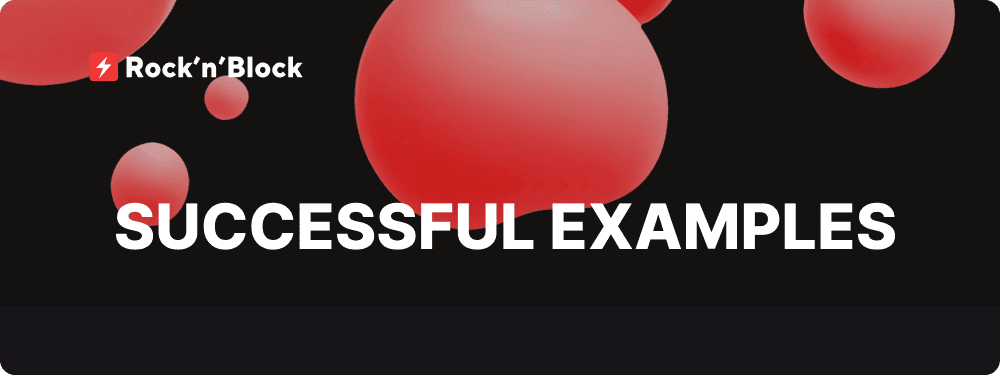
1. OpenSea
OpenSea is one of the most well-known and largest NFT marketplaces. It supports a wide range of digital assets, including digital art, virtual real estate, domain names, music, and more. Users can easily create, buy, sell, and trade NFTs on this user-friendly platform. OpenSea has gained immense popularity for its extensive collection of NFTs and user engagement.
2. Rarible
Rarible stands out for its commitment to decentralization. It operates on the Ethereum blockchain, and its unique feature is the RARI governance token, which empowers users to influence platform decisions. Artists can also create NFTs with customizable and unlockable content. Rarible is known for its focus on community engagement and creator empowerment.
3. Blur
Blur is a platform that brings the concept of NFTs into the realm of photography and visual arts. It provides photographers and artists with a space to showcase their work and earn revenue through NFT sales. What sets Blur apart is its mission to establish NFT photography as a mainstream art form. This niche platform is perfect for photographers looking to explore the world of NFTs.
Conclusion
Embarking on NFT marketplace development from scratch presents an exciting venture into the realm of digital assets and blockchain innovation. Our thorough guide details the key stages, considerations and complexities involved in a customized NFT marketplace development suited to your aspirations.
At Rock'n'Block, our passion is to turn visions into reality. Our experienced team combines technical expertise with a deep understanding of the rapidly changing blockchain landscape. Whether you're ready to bring your NFT marketplace concept to life or looking for expert guidance in navigating the intricacies of development, we invite you to contact us right now!
Let's collaborate to create a cutting-edge NFT marketplace that sets you apart in this dynamic and transformative digital arena. Get in touch with us today, and let's embark on this exciting journey together!
We ❤️ Development
Follow us on social media to receive the hottest blockchain development updates
Crunchbase ⚡️ Twitter ⚡️ Telegram ⚡️ LinkedIn ⚡️ Facebook ⚡️ Zupyak ⚡️ Quora ⚡️ Reddit
